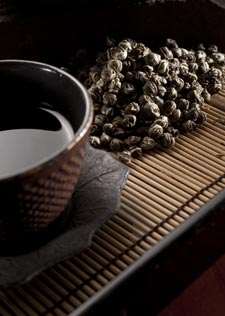
Soothing Skin Bath Soak
Chamomile is a common name for an herb that usual includes both the Roman and German varieties. Once called ‘maythe’ or ‘mayweed’, the name is based on an old English word for ‘maide’ or ‘woman’ and is probably due to the plant’s calming, relaxant effects which have been used to soothe menstrual pains (Pollington2000). While both varieties have similar action,
German chamomile is purported to be better tasting and milder in action that Roman Chamomile, which makes the former a better choice for pregnant women and children.
Chamomile is a commonly known herb that has amazingly wonderful, diverse qualities. It is traditionally used as a remedy for teething or cranky babies, to relieve and upset stomach, to ease menstrual cramps, and to reduce tension and induce sleep (K&W2001). Though individuals who have ragweed allergies may find that they are allergic to topical application of chamomile poulstices or salves, an allergic reaction is fairly unusual. In addition, in treating eczema, chamomile has been found to be as effective as hydrocortisone (steroidal cream) and superior to nonsteroidal anti-inflammatories (Aertgeertsetal1985). My own daughter has had eczema since she was an infant, and I have been delighted to find that a lotion created with chamomile & calendula infusions in both distilled water and natural vegetable oils has provided wonderful eczema relief. I now offer this lotion in my shop, primarily targeted for use for individuals with eczema, for children & infants, and for those with sensitive skin, though this lotion is fine for anyone and has a light scent of chamomile tea without the use of any fragrance or essential oils.

Chamomile
Chamomile is a wonderfully calming herb, both calming to the skin (as above) and calming to the tummy, the mind, the body, and the spirit. It gently brings someone into a state of restful sleep, and soothes even an irritated baby or newborn struggling with colic. German Chamomile has a long history of use during pregnancy and breast-feeding and is a common tea in Europe, Central America, & South America. (That said, it is important to note that Roman Chamomile has been found to have aborficent effects in studies on animals, and so it is important to choose German Chamomile over the Roman variety.) Part of chamomile’s calming effect on the nervous system is the large amount of easily assimilable calcium, making it a great herb to treat insomnia, nervousness, irritability, restlessness, and nighmares, along with connected conditions such as hypertension and cramps, spasms, and stomach distress. Menstrual cramps can be eased with the combination of chamomile & ginger (Tierra2003).
Conditions for which chamomile is beneficial are myriad, and include irritable bowl syndrome, indigestion, infant colic, gastric reflux disease, dysmenorrhea (cessation of menstrual cycle), gastritis, stress-related insomnia, peptic ulcer disease, spastic colon, cramping w/ diarrhea, oral ulcers, topical wound healing, eczema, and anogenital irritation. Chamomile can be taken in many forms: dried flowers, capsules, cream, salve, tea, tincture, bath tea or salt blend, but in this case we are fortunate because chamomile both smells and tastes lovely! I use chamomile in several different bath tea blends, including my Dream Journey bath tea

Chamomile & Calendula body lotion
Dried flowers can be added to the tub or in a muslin bag and in combination with epsom salts, this remedy can be very beneficial for hemorrohoids or irritated skin. Add a handful of oatmeal to the bag and you have a soothing emollient, combined with chamomile’s anti-inflammatory powers to aid allergic skin rashes, eczema, or just as a wonderfully soothing bath for baby. Topical poulstices made from the dried flower (clean cloth dipped into a water infusion) is useful for treating mastitis or other inflammatory issues
I find that the smell of the essential oil is a bit cloying and not always reflective, in my mind, of the light sweetness of the dried flowers, but the essential oil also has therapeutic action and is a welcome (though sometimes expensive!) addition to facial creams that require some ‘calming’ action to facial tissue. It is also good to use in balms and salves for children, as it is both therapeutic and very safe for all ages. For insect bites, the essential oil can be mixed with some aloe vera gel and applied directly to the bite.
Contraindications are few, though it may potentiate anticoagulants such as warfarin so use should be cautious and monitored if an individual is taking such a pharmaceutical. Again, though chamomile has a long, empirical track record of use for pregnant & breast-feeding mothers, it’s probably a good idea that Roman Chamomile be avoided throughout pregnancy (breastfeeding would be okay) and perhaps even in the first trimester because of chamomile’s mild emmenogogic effect (brings on menstruation). Chamomile overall represents one of the safest possible herbs for use with infants, childrens, and nursing mothers, who deliver the benefit of the tea through their breastmilk, and therefore is one of my herbs of choice in bath teas and products for babies, though it’s light, sweet fragrance and flavor certainly add to the strengths of this gentle giant. I say ‘giant’ because its gifts to us are so great.
REFS:
Aertgeerts, P. et al (1985) Z Hautkr. 60(3):270-277
Kuhn, Merrily and David Winston (2001) Herbal Therapy & Supplements: A Scientific and Traditional Approach
Pollington, Stephen (2000) Leechcraft: Early English Charms, Plantlore, and Healing
Tierra, Leslie (2003) Healing with the Herbs of Life




 Posted by lilithsapothecary
Posted by lilithsapothecary 



